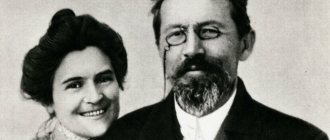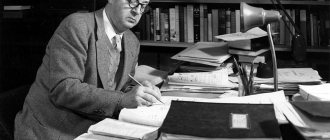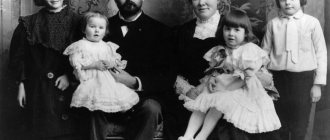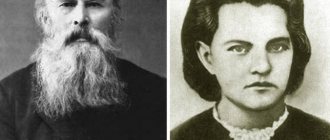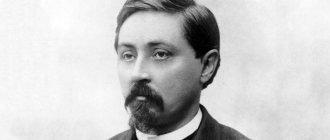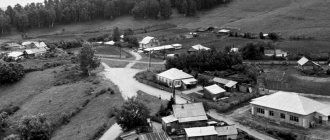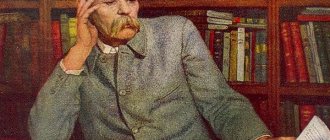Pyotr Ershov entered the history of Russian literature as the author of “The Little Humpbacked Horse,” a literary fairy tale in verse, which was based on the traditions of Russian folk tales, and Pushkin’s fairy tales.
The rest of Ershov’s work is known only to specialists, and his literary archive with unpublished works was lost.
Nevertheless, even one incredibly talented work ensured Ershov’s immortality.
After all, many more prolific writers disappeared from the memory of readers instantly, but Ershov’s fairy tale is still read.
Brief biography of Pyotr Ershov for elementary school children
Pyotr Ershov was born in the village of Bezrukovo, Tobolsk province, into the family of a police official.
Due to the father's duty, the family often had to change their place of residence; the Ershovs had to travel throughout Western Siberia.
In 1824, Pyotr Ershov and his brother Nikolai went to Tobolsk, where they entered the gymnasium.
The boys studied well, and after graduating from the gymnasium with honors, both went to St. Petersburg, where the service brought their father.
In the capital, Ershov enters the university, but studies carelessly, neglecting many subjects, and passing exams by pure luck.
As the writer himself admitted, great laziness prevented him from studying.
Ershov never learned a single foreign language, and he simply hated Latin.
But it was during his years of study that Ershov wrote the famous fairy tale “The Little Humpbacked Horse,” which he presented as his diploma work in Russian literature.
Professor Pletnev even read excerpts from the fairy tale from the pulpit, he liked the creation of the young writer so much.
The Little Humpbacked Horse was published as a separate book in 1834.
However, after such an impressive success, Ershov’s further literary life did not work out.
He wrote a lot, but most of his works were received rather coolly by the public.
Ershov was never able to repeat the success of The Little Humpbacked Horse.
Soon after graduating from the university, his father dies, his mother is seriously ill, and Ershov is forced to return to Tobolsk, where he becomes the director of the gymnasium and trustee of public schools.
Ershov marries twice, but both of his wives soon die.
And out of fifteen children, only four are selected from infancy.
Ershov’s health turns out to be undermined by hard work, and barely having retired, Ershov dies, there in Tobolsk, at the age of 55.
Personal life
Despite the success of the fairy tale, the biography of Pyotr Ershov is full of sorrows. For a long time he could not find personal happiness. Was married three times. His difficult life led him to despair.
Having buried his father, brother and mother, the writer at the age of 23 meets a widow with four children, Serafima Lescheva. She was a beautiful and educated woman. Their happiness was short-lived: they buried both of their daughters. Soon Seraphim also dies during childbirth. Ershov lived with her in marriage for five years.
The second marriage with Olympiada Kuzmina also did not last long. Ershov's second wife also dies. With children in his arms, the writer greatly experienced these life’s sorrows.
The writer's third wife was Elena Cherkasova. He lived with her until his death. In total, Ershov had 15 children in his marriages, but only four of them lived to adulthood. In 1856, a man wrote a message to his friends. In it, he said that he buried his son and daughter in one week. The writer's happiness was mocking.
In short, despite careless training at the gymnasium and university, Pyotr Pavlovich managed to become an excellent teacher whom children loved. He worked at the Tobolsk gymnasium, where he was an inspector. 20 years later he became the director of this educational institution . During his “reign” at the gymnasium, the writer opened six girls’ schools in the province. The students received an excellent education there. The schools were kept in good order and were under the control of the director.
Ershov Pyotr Pavlovich
Family and childhood
Pyotr Pavlovich Ershov was born in Western Siberia in the village of Bezrukovo, in the Ishim district of the Tobolsk province (in 1960 the village of Bezrukovo will be renamed Ershovo).
Father - Pavel Alekseevich Ershov, came from “children of clerks”. He served as an official in various positions in the judicial, financial, and police departments. He was not rich and lived “from service.” Mother - Efimiya Vasilievna Ershova, née Pilenkova, daughter of a wealthy Tobolsk merchant. Her ancestors were gunsmiths; they came to Siberia during the reign of Peter I. Subsequently, the artisans became merchants. Her father traded with China and also sold livestock.
Pavel Ershov was forced to move frequently for work reasons. Having begun his service in 1801 in the ancient Siberian city of Tara, he was subsequently transferred to Tobolsk, where he served as chief clerk and later as treasurer in the local treasury. In Tobolsk, he met his future wife, a merchant’s daughter, Efimiya Vasilyevna Pilenkova. They got married there - in 1807 in the Zakharyevskaya Church, about which there is a corresponding entry in the registry book. In the same year, Pavel Alekseevich was appointed to the post of commissar in the Cheremshan part of the Ishim district.
After the appointment, the family moved for permanent residence to the village of Bezrukovo, the native village of the poet’s father. It was there, in Bezrukovo, that Pyotr Pavlovich Ershov, the future author of the immortal “The Little Humpbacked Horse,” was born. Interesting fact: due to the fact that the child was born very weak, the parents decided to immediately baptize him, which was done on his birthday. Since Bezrukovo did not have its own church, the christening took place in Ishim in the Church of the Epiphany. This temple was famous for organizing the winter Nikolsky fairs, famous throughout Siberia.
But, despite the fervent parental prayers, the boy became increasingly weaker. The child was slowly fading away and was already dying. The unhappy parents decided to take a desperate step. They performed a local magical ceremony. Its essence was this: the child was sold to a beggar for a penny; it was believed that in this way the “buyer” took with him all the illnesses of the newborn. Subsequently citing this incident from his infancy, Ershov liked to joke, saying that the price was only one penny.
Ershov’s childhood itself took place in different Siberian towns. Stepnoy Petropavlovsk, Omsk and, finally, Berezov. A city very famous in history thanks to its famous exiles: His Serene Highness Prince Alexander Menshikov, Prince Alexey Grigorievich Dolgorukov, Count Andrei Ivanovich Osterman lived in Berezovo at different times. All these places became a temporary refuge for the Ershov family.
By 1825, after changing several places of service, the Ershovs again found themselves in Tobolsk. They live in the house of their uncle, Nikolai Stepanovich Pilenkov. Nikolai Stepanovich was a famous man in the city, a millionaire philanthropist. My uncle showed great concern for his nephews, Pyotr and Nikolai Ershov. Pavel Alekseevich was well aware of the importance and usefulness of quality education for his sons. For this reason, in 1827, Pyotr Ershov, together with his brother Nikolai, entered the Tobolsk gymnasium.
Since 1827 Ivan Pavlovich Mendeleev, who was the father of the future brilliant chemist Dmitry Mendeleev, becomes the new director of the gymnasium. Ivan Pavlovich was a remarkable man in many ways. He began his activities by transforming the gymnasium from a four-grade school to a seven-grade school. Such a system provided an opportunity for a more in-depth study of all necessary disciplines, and in addition, graduates of the gymnasium now had the right to enter higher educational institutions in Russia. The new director was a supporter of a creative approach to teaching children. “Literary Sundays” were organized for high school students, which were conducted personally by Ivan Pavlovich. They hosted public readings of Russian and foreign authors, discussions took place, and students were also given the opportunity to read their own works, if any. It was then that Ivan Pavlovich noted the abilities of young Ershov. The boy's father was constantly traveling on business. Since the Ershov and Mendeleev families were related, Ivan Pavlovich took upon himself the difficult task of instructing the boy on the righteous path of education. He invited him to his home, talked, and gave him many interesting books to read. In the future, Pyotr Ershov will speak of his mentor with great gratitude. Subsequently, already being an inspector of the Tobolsk gymnasium, Ershov will take an active part in the fate of Ivan Pavlovich’s son, the talented scientist Dmitry Mendeleev. By the will of fate, an amazing change of roles will occur. Dmitry Mendeleev will lose his wonderful father at the age of 13, and it is Pyotr Pavlovich Ershov who will become his support, as well as a mentor and loyal friend. He advises him to enter the St. Petersburg Pedagogical University. And that’s not all, after years, already living in St. Petersburg, Dmitry Mendeleev marries Ershov’s stepdaughter, Feozna Nikitichna Leshcheva.
During the same period, fate brought Ershov together with another famous fellow countryman - composer, pianist, author of brilliant romances - Alexander Alexandrovich Alyabyev. The composer was in Tobolsk as an honorary exile. Local high society gladly invites Alyabyev to all kinds of receptions and creative evenings. Alexander Alyabyev - an energetic man, a hero of the Patriotic War, the most talented musician of his time, in an indescribable way enlivens the atmosphere of the Siberian province. In Tobolsk, with the help of local patrons, he organizes a series of wonderful concerts, which attract audiences from all districts of the vast Tobolsk province. Ershov’s uncle, merchant Nikolai Stepanovich Pilenkov, took an active part in organizing concerts and participated in resolving organizational and financial issues.
It was at one of these evenings that a wonderful meeting took place between the future author of the unique “The Little Humpbacked Horse” and the author of the delightful romance “The Nightingale.” Ershov loved music very much; he knew how to play the flute and organ. The young high school student enjoyed taking part in home concerts, which were often held at his uncle’s house.
In the 1830s. The Ershovs successfully graduate from high school. For their diligence, the brothers were awarded a certificate of merit and a book. In Tobolsk, young Ershov showed serious interest in Siberian folklore. He collected and wrote down ancient legends and fairy tales.
Petersburg youth
In 1830, the father of the future poet sought a transfer to St. Petersburg. He receives an officer position and appointment to a separate corps of internal guards. The move became possible thanks to the patronage given by the former Governor-General of Western Siberia, Pyotr Mikhailovich Kaptsevich. In Siberia, Pavel Ershov served under Kaptsevich, was noticed and noted. Having settled in St. Petersburg, the father summons the rest of the family. Thus, the Ershovs found themselves in the incomparable Northern Palmyra.
Sovereign St. Petersburg with its majestic architecture of the imperial capital greatly impressed the young Siberian. This city will bring him acquaintance with people who will later become eternal, bright beacons in the horizon of his difficult life.
The family rented an apartment on Grafsky Lane - in the house of the captain’s widow, Madame Pomerantseva. Upon arrival in the capital, Pyotr Ershov submits a request to be enrolled as a student at the Faculty of History and Philology of the St. Petersburg Imperial University.
However, poor knowledge of Latin and Greek, as well as complete ignorance of any European language (at the Tobolsk gymnasium these subjects were taught poorly, and sometimes not taught at all) did not allow him to enter the Faculty of History and Philology. He was accepted to study philosophy and law. However, in the future, Ershov will still achieve the right to attend lectures in the historical and philological department, although only as a volunteer student. At the same time, Peter’s older brother, Nikolai, who has a penchant for exact sciences, entered the Faculty of Physics and Mathematics. At the university, Ershov, by his own admission, was not particularly diligent. The poet complained about his laziness and said that he was a dropout, especially when it came to speaking a foreign language.
In 1833, grief came to the Ershov family. His father died suddenly, and soon after this in August 1834, Peter’s older brother, Nikolai. Ershov was left alone with his sick mother. Their financial situation becomes extremely difficult.
At the university, one of the teachers of the young Ershov was professor of Russian literature Pyotr Aleksandrovich Pletnev (since 1832 rector of St. Petersburg University). Pyotr Pletnev is a poet and critic, a friend of Alexander Sergeevich Pushkin, his closest associate in publishing. He helped in the printing of more than 20 books by Pushkin. A selfless assistant and comrade of the great Russian genius. Alexander Sergeevich dedicated the poem “Eugene Onegin” to him. In his dedication, Pushkin precisely defined Pletnev’s qualities, calling him a man of “a beautiful soul, a holy dream fulfilled, lively and clear poetry, lofty thoughts and simplicity.” Pushkin himself called him “breadwinner” and “benefactor.” They were family friends. Pletnev is an active contributor to Pushkin’s magazine Sovremennik. After the poet's death, he continued the business of publishing the magazine.
Not long ago the Patriotic War of 1812 died down, and the ideas of the Russian nationality were very popular in Russian society. At the university, in the student literary circle, new brilliant works of wonderful authors were lively discussed: “Tales of the Cossack Lugansky” by V. I. Dahl, “Evenings on a Farm near Dikanka” by N. Gogol, and, of course, the fairy tales of Pushkin. In 1834, Professor Pyotr Pletnev proposed to students the topic of a new course work - folk art. When reviewing the completed tasks, Pletnev was completely delighted with the work of student Ershov. The teacher’s delight was so sincere that the professor considered it necessary to read the course work of their friend Ershov directly to the students sitting in the audience during the lecture. This was the first part of the brilliant poetic fairy tale “The Little Humpbacked Horse”. And immediately a resounding success. Pletnev did not fail to show the fairy tale to Pushkin. Alexander Sergeevich spoke about the fairy tale in the most enthusiastic tones. For example, the famous phrase of the great Russian poet is widely known: “Now I can leave this kind of poetry.”
In 1834, the fairy tale was published in the magazine “Library for Reading” by the publisher O. I. Senkovsky. In the same year, the tale, consisting of three parts, was published in a separate edition. At that time, its author was only 19 years old. The book immediately won the love of readers. The light, graceful, bright, fascinating fairy-tale verse appealed to the Russian people. During Ershov’s lifetime, his “The Little Humpbacked Horse” was published as many as seven times. By the end of the 19th century. The fairy tale has firmly taken its well-deserved and honorable place on the shelves of Russian libraries. Pletnev introduces Ershov to his friends, the best poets of his time - Pushkin and Zhukovsky. Both of them appreciated the talent of the young poet. Famous piits tried in every possible way to support the young writer.
And only the critic V.G. Belinsky gave a negative review. In his opinion, “The Little Humpbacked Horse” was just a successful counterfeit of true folk art. He wrote that there are Russian words in this work, but the Russian spirit is missing. However, he attributed Pushkin’s fairy tales to the same category.
The role of Pushkin’s name in the story of “The Little Humpbacked Horse” is interesting. It is reasonable to assume that Pushkin’s amazing tales had a serious influence on Ershov. Perhaps, even indirectly, they helped the “Humpbacked Horse” to be born. For some time there was even a version that the first four lines of the fairy tale were written by Alexander Sergeevich:
“Behind the mountains, behind the forests, Beyond the wide seas, Not in the sky - on earth There lived an old man in a certain village.”
At a certain time, these lines were even included in the complete collection of works of the great poet. Subsequently, literary researchers seriously questioned this version. Ershov’s lines were no longer published in Pushkin’s publications. To this day, debates on this slippery topic have not subsided among scientists.
The young writer spends most of his time on personal writing. In 1835 Ershov was published in the wonderful handwritten magazine “Snowdrop”. The initiator of the publication of the magazine was the talented poet Apollo Maykov. This handwritten publication was the favorite brainchild of the Maykov family; such authors as I. A. Goncharov and V. G. Benediktov started there.
In St. Petersburg, Pyotr Ershov became seriously interested in theater and was known as a regular at the opera. His favorite theater is musical. Ershov, in love with music since childhood, meets gifted St. Petersburg musicians. His friend, teacher and composer Osip Gunke, teaches Ershov to play the flute.
The Ershovs’ father, being an honest servant and an ardent “zealot of the throne,” strictly monitored his sons so that young people would not get carried away by the free-thinking ideas that were so widespread among the student community of that time. Having served in the department involved in supervisory activities, he, as an officer of the internal guard, was well aware of the danger of such ideas. Mother Siberia was overflowing with exiled freedom lovers. A monarchist “from brain to bone,” he passed on his beliefs to his son, Pyotr Ershov.
We know that Ershov did not have many acquaintances among the students. There were only a few close comrades. One of them is Andrey Yaroslavtsev. They became close over their passion for literature. Subsequently, Yaroslavtsev would become a writer, as well as Ershov’s first biographer. In 1872, Yaroslavtsev will release the first biography of memories of an unforgettable university friend, the main source of which was the invaluable personal correspondence between Ershov and Yaroslavtsev. Also among Ershov’s friends were Konstantin Timkovsky (grandson of the famous navigator G. Shelikhov), M. Masalsky (brother of the writer K. Masalsky) and Vladimir Von Treborn.
The young Siberian continued to successfully write and publish. In 1834–1836 from his pen came the play “Suvorov and the Station Warden” and the drama “Thomas the Blacksmith,” as well as a dozen poems. With the support of his good friend, composer Osip Gunke, Ershov wrote the libretto for the fairy-tale opera “The Terrible Sword,” but, alas, despite the positive reviews, the opera was never staged.
In 1836, having left the university, Ershov, although he had an ardent desire to stay in St. Petersburg, was still forced to submit a petition for appointment to a teaching position in the city of Tobolsk. The reason is banal - lack of money. The Ershovs were poor, had no fortune, no servants, and lived only from service income.
Tobolsk prose
After some time, the request was approved. Ershov returns to Tobolsk to serve in his native gymnasium. At first he taught Latin, but later he began to read philosophy and literature in senior gymnasium classes. It cannot be said that the arrival of a metropolitan celebrity caused delight among the gymnasium management. Judging by Ershov’s letters to his St. Petersburg friends, the director of the gymnasium E.M. Kachurin is a retrograde and formalist, a poorly educated person, who bullied young teachers in every possible way, not excluding Ershov.
On June 2, 1837, a significant event took place in the life of the Tobolsk gymnasium. This institution received the highest visit from the heir to the Russian throne, the future Tsar Alexander II. Teacher Ershov, who was present at the reception, “had the good fortune to present his laudatory ode to the heir,” as well as the score for the opera “Siberian Day,” specially written in honor of the Tsarevich’s arrival. For which he was awarded 500 rubles in banknotes. Together with the heir, Ershov’s old St. Petersburg acquaintance, the famous poet Zhukovsky, also arrived in Tobolsk. Vasily Zhukovsky, being the mentor of the Grand Duke, introduced and recommended Ershov in the most remarkable way. After this incident, Ershov began to hope for a return to St. Petersburg. However, these dreams were not destined to come true.
In 1838, in the Sovremennik magazine, Ershov published the poem “Suzge” - a dramatic work written on the basis of Siberian legends. Belinsky noted the deep intent of the poem, but did not fail to reproach the poet for being too verbose. The poem was repeatedly staged, and an opera of the same name was written based on it.
Ershov went to Siberia, inspired by many educational ideas, he was filled with creative plans. Plans and maps of ethnographic expeditions have already been drawn up. However, alas, none of these great plans were destined to come true. Ordinary life, sometimes quite unfairly called “routine,” decisively interfered with the poet’s creative plans.
In 1839, Ershov passionately fell in love and married Serafima Aleksandrovna Leshcheva, a widow who already had four children. Serafima Aleksandrovna, the daughter of the former director of a gymnasium in Tobolsk, a beautiful and educated woman, an experienced and practical lady, does not immediately, but nevertheless, agree to marry a young teacher.
After marriage, Ershov’s life undergoes serious changes. He is forced to concentrate on getting his daily bread. Throughout his life, Pyotr Pavlovich Ershov will face many difficult trials. Death mercilessly mowed down the poet's loved ones. In his youth, in a very short time, he lost his father, older brother, and mother. He was a widower twice (he married three times in total). The study of documents, primarily Ershov’s letters, made it possible to establish that the poet had 15 children from three marriages, of whom only four survived to adulthood. The rest died in infancy. Fate mercilessly beat and tossed Ershov around. However, even under the saddest circumstances and difficult living conditions, the poet continued to create. Pyotr Pavlovich was a deeply religious man and accepted these terrible sorrows with true Christian humility. Religion was one of the main sources of inspiration for the poet. During the Siberian period, several works of various formats came from his pen: the true story “The Siberian Cossack”, the poem “Suzge”, a series of stories “Autumn Evenings”, as well as poems. We know that Ershov had plans to create a 10-volume Siberian fairy-tale epic entitled “Ivan Tsarevich - a Tale of Fairy Tales in Ten Books and One Hundred Songs.” To our great regret, this idea never came to fruition.
In 1844 Ershov was appointed inspector of the gymnasium. On the path of teaching, he proved himself to be a progressive and highly spiritual mentor. Under his direct supervision, a gymnasium theater was organized. The theater staged plays by famous authors, as well as works written by Ershov himself. During his teaching career, Ershov wrote and sent to St. Petersburg two voluminous scientific works designed to improve the quality of education in Russian gymnasiums: “Thoughts on the gymnasium course” and “Course of Russian literature.” The latter was even accepted for publication, but in the end the work was rejected by the censors. Ershov sincerely cared for the fate of Russian education, he tried to achieve changes in the gymnasium program. He dreamed of seeing the works of Pushkin and Zhukovsky, so beloved by him, in the curriculum.
A large number of exiled Decembrists were kept in Tobolsk. Ershov was personally acquainted with many: V.K. Kuchelbecker, A.I. Muravyov, M.A. Fonvizin and many others. Together with the Decembrist, poet N. A. Chizhov, Ershov will write a vaudeville entitled “Skull Apostle, that is, Phrenologist.” Subsequently, the poet V. M. Zhemchuzhnikov, who served for some time in Tobolsk, with Ershova’s personal permission, uses one of the vaudeville scenes to create an operetta of the same name. V. M. Zhemchuzhnikov is one of the creators of the famous “Kozma Prutkov”. In the future, the operetta will be included in the collected works of Kozma Prutkov and will be published in the Sovremennik magazine. In Fonvizin’s house, Ershov reads a cycle of seven stories called “Autumn Evenings. Ershov pinned certain hopes on returning to great literature with these stories, however, he had no success. Only thanks to the help of Ershov, the Decembrist I. I. Pushchin was able to transfer previously unknown poems by Pushkin to the Sovremennik magazine for publication.
In 1857, Pyotr Pavlovich was appointed director of the gymnasium in Tobolsk, as well as schools in the Tobolsk province. Ershov undoubtedly had remarkable teaching talent. According to contemporaries, the children loved and immensely respected Pyotr Pavlovich. To confirm this, one curious document has been preserved in the archives - the program of the performance, which was staged by high school students on February 22, 1842 in honor of the birthday of their beloved teacher P. P. Ershov.
The official description of Ershov from 1857 is worthy of attention, and the “List of Persons Deserving the Government’s Attention” notes that he is “an intelligent, kind and honest person.” During his tenure as director of the gymnasium, Ershov managed to open 6 new girls' schools in the province. They were all kept in excellent order and provided the students with a decent level of education.
On March 20, 1858, P. P. Ershov again visited St. Petersburg, the city of his famous youth. It was a business trip on the affairs of the gymnasium: he was called to meet with the Minister of Education.
In 1862 Ershov retired. In the last years of his life, he became close to the talented Siberian artist and writer Mikhail Stepanovich Znamensky. After Ershov’s death, Znamensky will help in reconstructing the biography of the last years of the life of Pyotr Pavlovich Ershov.
Dmitry Ivanovich Mendeleev, a former student and old friend of Ershov, who lived in St. Petersburg, was trying to get a pension for Ershov, and he also made a lot of efforts to publish the 6th and 7th editions of The Little Humpbacked Horse. In Ershov’s homeland, in the village of Bezrukovo, with the direct participation of the poet, an Orthodox church was built, dedicated to St. Peter the Stylite. Unfortunately, the temple was destroyed in 1969.
Pyotr Pavlovich Ershov died in Tobolsk on August 30, 1869. He was buried there, at the Zavalny cemetery. On the gravestone it is written: “Pyotr Pavlovich Ershov, author of the folk tale “The Little Humpbacked Horse.” In 2008, in Tobolsk, in the Ershov park, a wonderful sculptural composition dedicated to the poet and his fairy-tale heroes was installed.
For millions of people, Pyotr Pavlovich Ershov was, is and will remain the author who wrote the unforgettable fairy tale “The Little Humpbacked Horse,” whose characters will live their endless fairy-tale lives. Since its existence, the fairy tale “The Little Humpbacked Horse” has been published in huge editions at least 130 times in 27 languages of the world.
Dmitry Sytov

